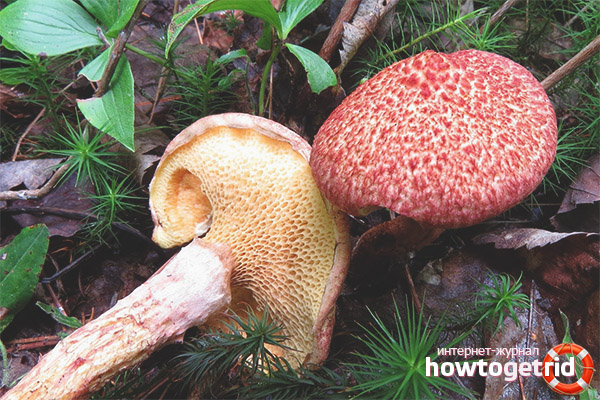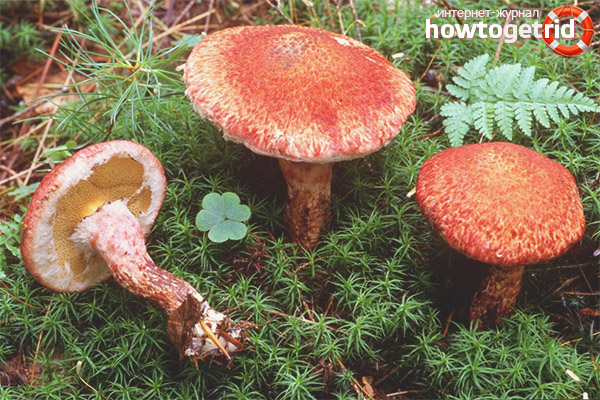The content of the article
In some cases, the name of the fruiting body is almost completely or partially consistent with its appearance. As for the painted oiler, when you look at it, you can immediately understand why such an instance was given the corresponding name. Mushroom pickers from all over the world are very fond of such fruiting bodies. Therefore, as soon as the fruiting period begins, mushroom pickers go on a quiet hunt.
Description
- Presented fruiting bodies also have a second name. Experts often call them Spray oiler. Such items have a fairly large hat size. Maximum in diameter, it can grow up to 18 cm. Over time, the hat takes the form of a cone. It is hemispherical, and in the center there is a small tubercle.
- At the edges of the hat you can see the hanging remains of the bedspread. Most often they look like flakes. Previously, the latter covered the tubular mass. Multiple flakes can be seen on the surface of the hat itself. Most often they are painted in gray-brown or brown. Due to this, such fruiting bodies seem very noticeable and variegated.
- It is worth noting an amazing fact, the color of the skin of such specimens can change depending on weather conditions. However, during rains, the mushroom acquires a brighter and darker color. As for young fruiting bodies, their hats are painted in wine red or burgundy. Sometimes a yellowish tint is observed.
- As for the pulp, it is painted in yellow. The structure is quite dense. It can blush if incised. After this, after some time, the flesh acquires a red-brown color. Below the cap you can see the tubular structure. It is formed from fused tubules that go down the leg.
- The tubular mass itself is often painted in a bright yellow or brown-ocher shade. If you press it, you will see a brown color. In young fruiting bodies, those same tubes are hidden under a fluffy bract. The latter may have a white-pink or white color.
- As for reproduction, the painted grease fitting makes this a smooth spore. They are in spore powder. It can also be brown, tan, or cinnamon-olive. As for the leg, it is quite long. It can grow up to a maximum of 12 cm in height and up to 3 cm in diameter.
- After the cover is destroyed, a gray or white ring remains on the leg. Over time, it begins to dry out and darken. In addition, above the ring and in the center of the leg you can see that the surface is painted in yellow. However, closer to the base you can see a rich ocher color.
Spread
- Fruit bodies prefer to develop and bear fruit in fertile soil. In addition, the latter is often covered with green moss. Instances in most cases grow with weymouth pines and cedar forests.
- Such fruits are harvested in European countries, conifers, Siberian, North American and Far Eastern forests. The advantage of an oiler is that it forms fairly large colonies. Because of this, a rich harvest is always obtained. Fruiting occurs from the beginning of summer until mid-autumn.
Edibility
- Such fruiting bodies are famous for their delicate mushroom aroma and mild taste. Therefore, without any doubt they are equated with the category of edible specimens of the mushroom world.
- These oils are marinated, stewed and roasted. They are also added to various first and second courses. In such mushrooms there is nothing harmful, they can be consumed even in raw form.
Similar views
- A remarkable oiler differs from its counterparts in modest size. If you look closely at the leg, then below the ring you can see the burgundy color. Moreover, her surface has a felt structure. The hat also does not have a large diameter. On its surface you can see scattered and fairly large scales.
- The centipede oiler is much smaller in comparison with the painted look. In addition, his leg is hollow and not filled with pulp. There are no pronounced scales on the hat. On the contrary, it seems to have a fleecy structure. Most often, it turns brownish.
- In the Asian nipple, the leg also remains hollow. The hat is colored bright. No flakes are observed on the surface. On the contrary, the hat has a felt structure. The surface is painted in bright burgundy or cherry color.
A painted oiler may look like some other fruiting bodies. Therefore, when collecting, you need to know about similar species. Fruit bodies are so safe that they can be consumed without heat treatment.











Submit